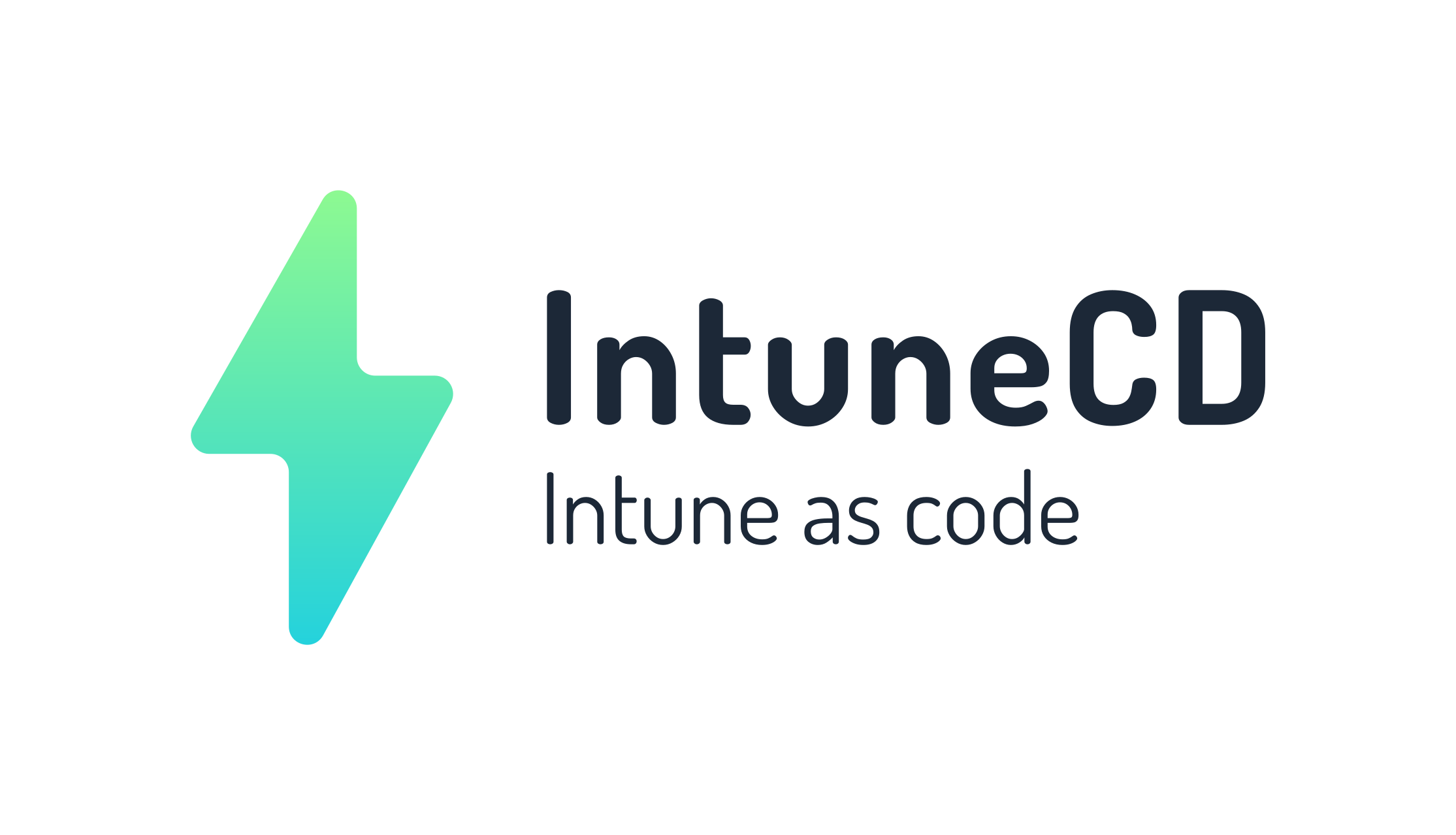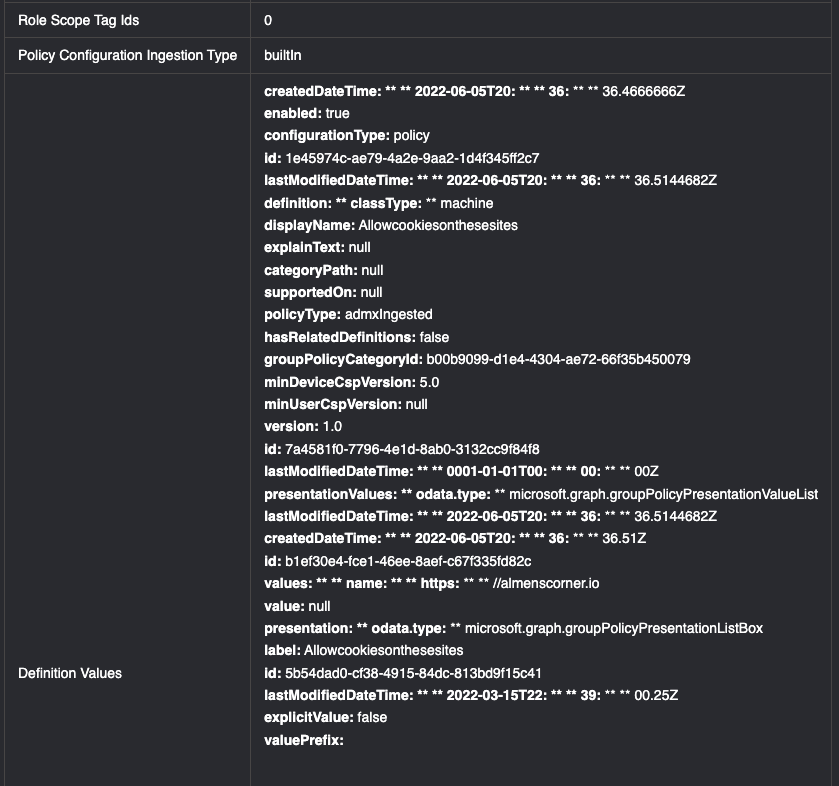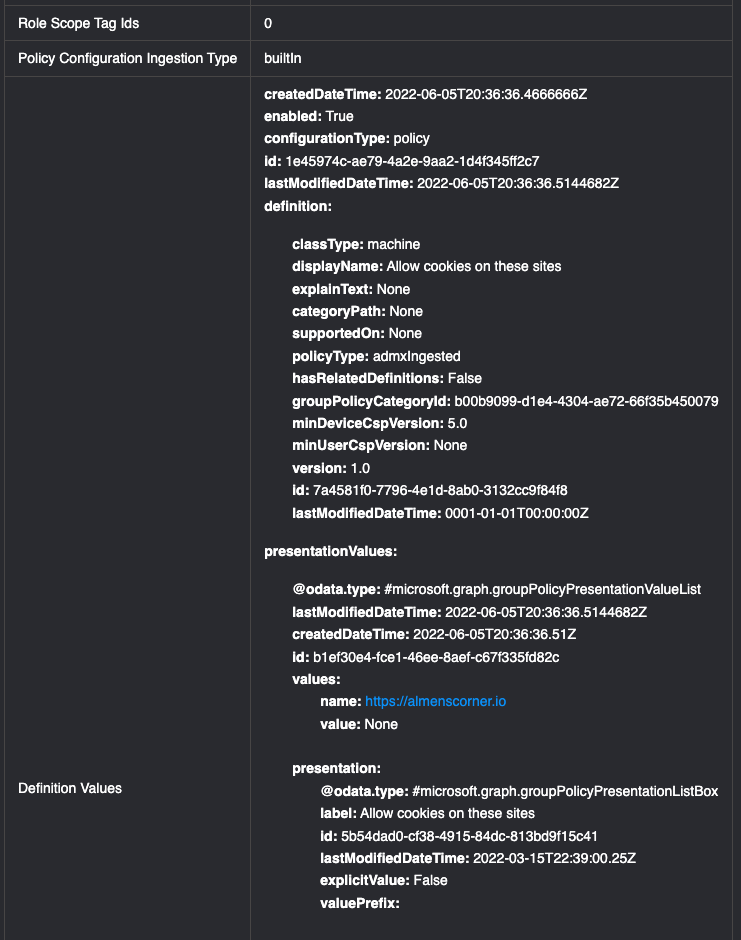Tool to backup and update configurations in Intune
Project description


IntuneCD or, Intune Continuous Delivery as it stands for is a Python package that is used to back up and update configurations in Intune. It was created with running it from a pipeline in mind. Using this approach we get complete history of which configurations have been changed and what setting has been changed.
The main function is to back up configurations from Intune to a Git repository from a DEV environment and if any configurations has changed, push them to PROD Intune environment.
The package can also be run standalone outside a pipeline, or in one to only backup data. Since 1.0.4, configurations are also created if they cannot be found. This means this tool could be used in a tenant to tenant migration scenario as well.
Exciting news 📣
The front end for IntuneCD has now been released. Check it out here
Whats new in 1.3.1
- Bug fix for Filters not being able to created if they do not exist
- Bug fix for Conditional Access policies not being able to be created if
authenticationStrengthis configured - Added Graph throttling handling to
makeapirequestPostto handle creation of large amounts of CA policies
What's new in 1.3.0
- New summary of changes, instead of just a count, a summary of the changes with old and new values are sent to the front end
- Report mode, if you want to send a summary of changes to the front end without actually updating the configuration in Intune, you can activate report mode when running the update using
-r->IntuneCD-startupdate -r
What's new in 1.2.7
- Documentation overhaul
-
The documentation module has been completely overhauled. It is now much easier to read. Below you can see a before and after example,
- Before
- After
-
I use Powershell, Do I need to learn Python?
No.
Just install Python and IntuneCD, that's it!
Install this package
pip install IntuneCD
Update this package
pip install IntuneCD --upgrade
What is backed up, updated, created and documented?
| Payload | Back up | Update | Document | Create | Notes |
|---|---|---|---|---|---|
| Apple Push Notification | :tada: | :tada: | |||
| Apple Volume Purchase Program tokens | :tada: | :tada: | |||
| Application Configuration Policies | :tada: | :tada: | :tada: | :tada: | |
| Application Protection Policies | :tada: | :tada: | :tada: | :tada: | |
| Applications | :tada: | :tada: | |||
| Compliance Policies | :tada: | :tada: | :tada: | :tada: | |
| Conditional Access | :tada: | :tada: | :tada: | :tada: | Assignments are not updated currently |
| Device Configurations | :tada: | :tada: | :tada: | :tada: | For custom macOS and iOS configurations, mobileconfigs are backed up |
| Group Policy Configurations | :tada: | :tada: | |||
| Enrollment profiles | :tada: [^1] | :tada: | :tada: | :tada: [^2] | |
| Enrollment Status Page | :tada: | :tada: | :tada: | :tada: | |
| Endpoint Security | :tada: | :tada: | :tada: | :tada: | Security Baselines Antivirus Disk Encryption Firewall Endpoint Detection and Response Attack Surface Reduction Account Protection |
| Filters | :tada: | :tada: | :tada: | :tada: | |
| Managed Google Play | :tada: | :tada: | |||
| Notification Templates | :tada: | :tada: | :tada: | :tada: | |
| Proactive Remediation | :tada: | :tada: | :tada: | :tada: | |
| Partner Connections | :tada: | :tada: | Compliance Management Remote Assistance |
||
| Shell Scripts | :tada: | :tada: | :tada: | :tada: | |
| Powershell Scripts | :tada: | :tada: | :tada: | :tada: | |
| Settings Catalog Policies | :tada: | :tada: | :tada: | :tada: |
[^1]: Only Apple Business Manager and Windows Autopilot profiles are backed up. [^2]: Only Windows Autopilot profiles are created.
Required Azure AD application Graph API permissions
- DeviceManagementApps.ReadWrite.All
- DeviceManagementConfiguration.ReadWrite.All
- DeviceManagementServiceConfig.ReadWrite.All
- Group.Read.All
- Policy.Read.All
- Policy.ReadWrite.ConditionalAccess
If you just want to back up you can get away with only Read permission (except for DeviceManagementConfiguration)!
How do I use it?
You have two options, using a pipeline or running it locally. Let's have a look at both.
Parameters
To see which parameters you have to provide just type: IntuneCD-startbackup --help, IntuneCD-startupdate --help or IntuneCD-startdocumentation --help
Example options:
- -h, --help show this help message and exit
- -o OUTPUT, --output=OUTPUT
- The format backups will be saved as, valid options are json or yaml. Default is json
- -p PATH, --path=PATH
- The path to which the configurations will be saved. Default value is $(Build.SourcesDirectory)
- -m MODE, --mode=MODE
- The mode in which the script is run, 0 = devtoprod (backup from dev -> update to prod) uses os.environ DEV_TENANT_NAME, DEV_CLIENT_ID, DEV_CLIENT_SECRET, 1 = standalone (backup from prod) uses os.environ TENANT_NAME, CLIENT_ID, CLIENT_SECRET
- -a LOCALAUTH, --localauth=LOCALAUTH
- When this paramater is set, provide a path to a local json file containing the following keys: params:TENANT_NAME, CLIENT_ID, CLIENT_SECRET when run in standalone mode and params:DEV_TENANT_NAME, DEV_CLIENT_ID, DEV_CLIENT_SECRET when run in devtoprod
For IntuneCD-startupdate 1.0.4 the -u parameter has been added which, if set, updates assignments for existing configurations. Again the groups are matched with displayName, so they must be the same in both tenants.
Run locally
First install the package using pip, then you must create a json which contains authentication parameters in the following format:
{
"params":{
"TENANT_NAME": "",
"CLIENT_ID": "",
"CLIENT_SECRET": ""
}
}
When you have created the json, you can now run these commands
IntuneCD-startbackup -m 1 -o yaml -p /path/to/save/in -a /path/to/auth.json/
If you run without the -m parameter, make sure you have one auth.json pointing to DEV and another pointing to PROD, example:
{
"params":{
"DEV_TENANT_NAME": "",
"DEV_CLIENT_ID": "",
"DEV_CLIENT_SECRET": ""
}
}
{
"params":{
"PROD_TENANT_NAME": "",
"PROD_CLIENT_ID": "",
"PROD_CLIENT_SECRET": ""
}
}
IntuneCD-startbackup -o yaml -p /path/to/save/in -a /path/to/auth_DEV.json/
IntuneCD-startupdate -p /path/to/save/in -a /path/to/auth_PROD.json/
Run from a pipeline
I have tested this with Azure DevOps which is what I will give an example to. But it could just as well be run using GitHub Actions.
In the example pipeline below I'm running with the parameters -m 1 (standalone mode) and -o yaml (output configurations in yaml format). If you are running this in DEV -> PROD mode, remove -m and add DEV_ in front of all env: variables except for REPO_DIR. CLIENT_SECRET should be added as a secret variable.
DEV env variables:
env:
REPO_DIR: $(REPO_DIR)
DEV_TENANT_NAME: $(TENANT_NAME)
DEV_CLIENT_ID: $(CLIENT_ID)
DEV_CLIENT_SECRET: $(CLIENT_SECRET)
Example backup pipeline:
pool:
vmImage: ubuntu-latest
variables:
REPO_DIR: $(Build.SourcesDirectory)
TENANT_NAME: example.onmicrosoft.com
CLIENT_ID: xxxxxxxx-xxxxx-xxxx-xxxx-xxxxxxxxxxxx
steps:
- checkout: self
persistCredentials: true
- script: pip3 install IntuneCD
displayName: Install IntuneCD
- script: |
git config --global user.name "devopspipeline"
git config --global user.email "devopspipeline@azuredevops.local"
displayName: Configure Git
- script: IntuneCD-startbackup -m 1 -o yaml
env:
REPO_DIR: $(REPO_DIR)
TENANT_NAME: $(TENANT_NAME)
CLIENT_ID: $(CLIENT_ID)
CLIENT_SECRET: $(CLIENT_SECRET)
displayName: Run IntuneCD backup
- script: |
cd $(REPO_DIR)
git add --all
git commit -m "Updated configurations"
git push origin HEAD:main
displayName: Commit changes
The following shows a pipeline which updates configurations in Intune. Again I'm running with -m 1. If this should update PROD, add PROD_ in front of all env: variables except REPO_DIR. CLIENT_SECRET should be added as a secret variable.
PROD env variables:
env:
REPO_DIR: $(REPO_DIR)
PROD_TENANT_NAME: $(TENANT_NAME)
PROD_CLIENT_ID: $(CLIENT_ID)
PROD_CLIENT_SECRET: $(CLIENT_SECRET)
Example update pipeline:
pool:
vmImage: ubuntu-latest
variables:
REPO_DIR: $(Build.SourcesDirectory)
TENANT_NAME: example.onmicrosoft.com
CLIENT_ID: xxxxxxxx-xxxxx-xxxx-xxxx-xxxxxxxxxxxx
steps:
- checkout: self
persistCredentials: true
- script: pip3 install IntuneCD
displayName: Install IntuneCD
- script: IntuneCD-startupdate -m 1
env:
REPO_DIR: $(REPO_DIR)
TENANT_NAME: $(TENANT_NAME)
CLIENT_ID: $(CLIENT_ID)
CLIENT_SECRET: $(CLIENT_SECRET)
displayName: Run update
Run documentation locally
To create a Markdown document from the backup files, run this command
IntuneCD-startdocumentation -p /path/to/backup/directory -o /path/to/create/markdown.md -t nameoftenant -i 'This is a demo introduction'
Run documentation in a pipeline
This step should be added to the backup pipeline to make sure the markdown document is updated when configurations changes. By default it writes to the README.md file in the repo, you can change this with the -o option
- script: IntuneCD-startdocumentation -t $(TENANT_NAME) -i 'This is a demo introduction'
env:
REPO_DIR: $(REPO_DIR)
displayName: Run IntuneCD documentation
Good to know
When this tool tries to update configurations, it matches the display name. Therefore, the display name from DEV must match in PROD.
Current known limitations
Updating Windows Update Rings configurations is currently not supported, the tool can however create update rings if they don't exist.
Project details
Release history Release notifications | RSS feed
Download files
Download the file for your platform. If you're not sure which to choose, learn more about installing packages.





















